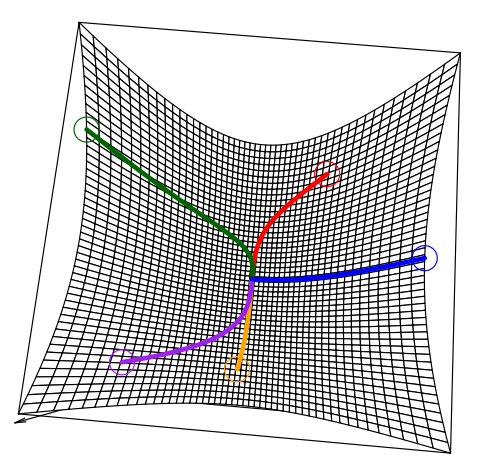1. gradient descent
1.1 Model to consider
Consider unconstrained, smooth convex optimization
i.e., f is convex and differentiable with
Gradient descent: choose initial value
x(0)
, repeat:
Stop at some point.
1.2 Interpretaion
1.2.1 Interpretation via newton method
Since for the smooth and convex function
f(x)
, the minimum satisfies a condition that
- If ∇f(x) can be calculated simply, we can get x∗ directly just by solving this equality.
- If
∇f(x)
is difficult to calculated. Then we can use linear approximation to
∇f(x)
at
x(0)
:
ℓ(x)=∇f(x(0))+∇2f(x(0))⋅(x−x(0))
and by setting this linear approximation to zero, we get
x(new)=x(0)−∇2f(x(0))−1∇f(x(0))
But for many functions, calculating their twice differential is difficult. So we can replace
∇2f(x)
by
1t⋅I
:
The core idea behind gradient descent is that using linear approximation of ∇f(x) to get the root of ∇f(x) , which is exactly Newton-Raphson method. Newton-Raphson method is a method for finding successively better approximations to the roots (or zeroes) of a real-valued function.
1.2.2 Interpretation via quadratic approximation of original function
Linear approximation of
∇f(x)
can be regarded as a quadratic approximation of the original function
f(x)
:
which satisfies that:
we can also use
1t⋅I
to replace
∇2f(x(0))
:
Then setting first differential of
f~(x)
to be zero:
we get
1.3 How to choose step size t(k)
If
t
is too large, we algorithm will not converge. If it is tool small, the algorithm will converge too slow. So how to choose a suitable
- fixed t
- The exact line search can be used if
f(x) is good enough:
t=argmintf(x−t∇f(x)) -
- But in most cases, we can use backtracking line search
- But in most cases, we can use backtracking line search
(i) set
β∈(0,1)
and
α∈(0,1/2)
fixed.(in practice, choose
α=1/2
)
(ii) at each iteration, start with
t=1
and while
shrink t=βt . Else perform gradient descent:
From backtracking line search, we can see that
which make sure that gradient descent is going on a exact descent direction.
1.4 Convergence analysis
Theorem:[lipschitz of first derivative with fixed t] if
f
is convex and differentiable,
proof:
- from lipschize properties of
∇f(x)
, we have
∥∇f(x)−∇f(y)∥2≤L∥x−y∥2f(y)≤f(x)+∇f(x)⋅(y−x)+L2∥y−x∥22 - from the definition of gradient descent method, we know
x+=x−t⋅∇f(x) - from the convexity of
f(x)
, we have
f(x∗)≥f(x)+∇f(x)⋅(x∗−x)
which can be written as
f(x)≤f(x∗)+∇f(x)⋅(x−x∗)
combining these three together, we have
So we have
summing all of these inequalities, we have
Then
Theorem:[lipschitz of first derivative with backtracking] if
f
is convex and differentiable,
where tmin≥min{1,βL}
proof:
All are the same as fixed t but for the value of
tmin
,
From the backtrack line search idea, we know that, there exists a
t0
such that for
∀t∈[0,t0]
, we have
So the final value of
tbacktrack∈(βt0,t0]
. From the equality of last theorem: we have
we know that t0=1L .
So
tmin∈(βL,1L]
and
tmin≤1
Theorem:[lipschitz of first derivative and strong convexity of function] If
f(x)
is m-strong convex and
∇f(x)
is L-lipshcitz function, then gradient descent with fixed step size
t≤2L+m
or with backtracking line search satisfies:
with 0<c<1
proof:
Then we have
and from the convexity of f(x)
1.5 Summarize
- For lipschitz gradient situation, gradient descent has convergence rate
O(1/k)
i.e., to get f(x(k))−f∗≤O(ϵ) , we need O(1/ϵ) iterations - For lipschitz gradient and strong function situation, gradient decent has exponential convergence rate.
Reference:
http://www.stat.cmu.edu/~ryantibs/convexopt/lectures/05-grad-descent.pdf
http://www.seas.ucla.edu/~vandenbe/236C/lectures/gradient.pdf
http://www.stat.cmu.edu/~ryantibs/convexopt/scribes/05-grad-descent-scribed.pdf

























 1273
1273

 被折叠的 条评论
为什么被折叠?
被折叠的 条评论
为什么被折叠?








